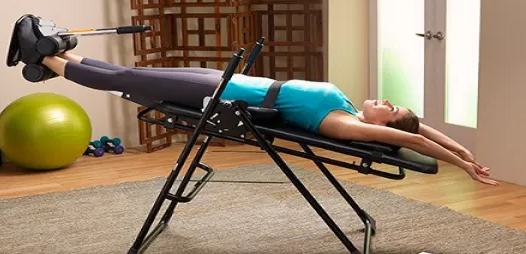Develop a healthier spine with inversion therapy. Combat gravity’s negative effects by adding inversion therapy to your spinal health repertoire. Decompress your spine and reduce joint pressure by lying on an inversion table.
Inversion therapy is a form of traction. Inversion therapy is extremely effective in decreasing pressure on the spine.
The inversion table is a therapeutic apparatus. It is designed to rotate the body into a position where the head is lower than the feet.
Inversion therapy is not for everyone. Contraindications include: Vertigo, dizziness, pregnancy, prosthetic legs, knee replacements, hip replacements, obesity, metallic implants in the spine, bone weakening diseases, high blood pressure, low blood pressure, stroke, TIA, glaucoma, conjunctivitis, retinal detachment, middle ear disorders, seizures, hiatal hernia, esophageal reflux, heart disease and blood disorders. If any of these conditions exist do not attempt to use an inversion table.
Seek professional medical advice before beginning inversion therapy. If symptoms are elicited during the use of an inversion table, stop immediately.
Start gradually to provide your body ample time to adjust to inversion therapy. Increase time and angle in very small increments. Move slowly into the inverted position and return to an upright position gradually.
I recommend against hanging straight down without the support of a back board. This includes gravity boots. Hanging straight down places unnecessary stress on the ankles and knees.
Therapeutic benefits of inversion therapy can occur at very small angles of inversion. Most inversion tables allow you to set the degree of downward angle.
One manufacturer developed an inversion table with built-in preset locks at three specific angles: Parallel to the floor, fifteen degrees down angle and thirty degrees down angle. This specific manufacturer also included a sliding backboard to increase the amount of traction.
Exercises may be performed on an inversion table. Take precaution, exercises are more difficult and place additional stress on the joints. Begin very gradually and pay close attention to your body’s signals before progressing.
Inversion tables are excellent sources of spinal traction. Gravity pushes down on the spine twenty-four hours a day. Several minutes of inversion therapy three to four times a week decompresses the spine.
Proper movement is vital to spine health. Inversion therapy provides spinal motion in a different direction and angle than other motions.
Utilize an inversion table to build a healthier spine. Combine inversion therapy with proper ergonomics, correct lifting techniques, exercise and chiropractic care to achieve and maintain spinal health.
Dr Donald A Ozello DC of Championship Chiropractic in Las Vegas, NV
Web Site: http://www.championshipchiropractic.com/
Blog: https://www.championshipchiropractic.com/wordpress/
YouTube: https://www.youtube.com/user/drdozellodc/videos
Twitter: https://twitter.com/drdozellodc
Facebook: https://www.facebook.com/Championship-Chiropractic-280141628688300/
LinkedIn: https://www.linkedin.com/in/dr-donald-a-ozello-dc-716b3233
“Running: Maximize Performance & Minimize Injuries” https://www.amazon.com/Running-Performance-Chiropractors-Minimizing-Potential/dp/1493618741
**Disclaimer: Always consult a medical professional before beginning an exercise program. Always work within your capabilities. Never perform an exercise that elicits or increases pain or symptoms. Reading this article and viewing the linked videos does not take the place of seeing a medical professional. Please visit a medical professional for evaluation, diagnosis & treatment.

